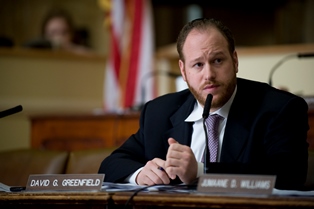
Councilmember David Greenfield, chair of the Committee on Land Use . Image credit: William Alatriste/New York City Council
Peter Koo and David Greenfield-sponsored bill was supported by Real Estate industry and vehemently opposed by preservationists. On June 8, 2016, the full City Council voted to approve a bill amending the City’s Landmark Law following a Land Use Committee meeting on June 7.
The legislation, Introduction 775, mandates that Landmarks vote on an item for designation as an individual, interior, or scenic landmark within one year of holding a public hearing. If the Commission does not hold a vote within the 12-month time span, the item will be removed from the Commission’s calendar. The Commission may extend the time frame by another 12 months with the owner’s concurrence if there is sufficient need. For historic districts, the Commission must take action within 24 months of the district’s initial calendaring. For all items that have been calendared prior to the law’s passage, the Commission must take action within 18 months of the law’s effective date, with a provision for a further 12-month extension with the owner’s consent.
Hearings were held on a prior version of the bill in September of 2015. The previous bill would have given Landmarks 180 days to hold a public hearing after calendaring, and 180 days following the hearing to take a dispositive vote. Council Member David Greenfield, who sponsored the bill along with Peter Koo, said the bill would rein in the Commission’s “indefinite decision making,” and characterized the legislation as a “good government reform.” Peter Koo said the bill would make landmarking more clear and predictive to average New Yorkers.
Another bill, sponsored by Daniel Garodnick, would have required Landmarks to post on its web site all requests for evaluation received by the Commission, as well as properties surveyed by Landmarks’ staff.
At a hearing, Landmarks Chair Meenakshi Srinivasan stated that the bills had the potential to undermine the Landmarks Law, as well as the agency’s efficacy. She said the timeframes in the bill were too short, and that the landmarking process, with its required research, public outreach, and available agency resources sometimes took as long as three years.
Many speakers testified on the bill, with preservationist organizations vociferously opposing the legislation as burdening and weakening a small and under-funded agency, and giving developers an incentive to obstruct and delay the landmarking process.
Proponents of the legislation included the Real Estate Board of New York, whose president, Michael Slattery, said would bring “greater predictability” for property and business owners. Representatives of the Buildings and Construction Trades Council, SEIU 32BJ, the Partnership for New York City, the Downtown Brooklyn Partnership, and the Manhattan Chamber of Commerce also supported the proposed timelines.
At the Committee meeting on June 7, Council Member Greenfield called the legislation “a long overdue measure,” that, as modified, constituted “a very modest reform.” He said the landmarking process has been, for the past 50 years, “too opaque,” “too unpredictable,” and frequently moving “too slowly.” He said the legislation would also prevent Landmarks from “running out the clock on a Council Member’s priorities,” by calendaring an item on a Council Member’s request and failing to take timely action. He said opposition to the bill was largely the result of “misinformation.” He noted that the modified bill would not inhibit the Commission’s ability to reconsider a landmark or district. The previously proposed bill would have placed a five-year moratorium on reconsideration. Peter Koo said the bill would create “a predictable timetable that provides reasonable expectations for both the community and property owners.” Koo further stated that critics of the earlier bill had been listened to, and the legislation accordingly modified by lengthening the timelines, creating the possibility for extension, and removing the moratorium on reconsideration.
Council Member Rosie Mendez spoke against the bill’s passage, saying the public should have the opportunity to comment on the modified bill, and that the timelines were still too short for Landmarks to adequately do its work. She also said there had not been opportunity for the Council to discuss the modified bill “in democratic conference.” Council Member Ben Kallos also criticized the bill’s reemergence on the committee’s calendar on the Thursday before the vote was to be held, and said the voice of the real estate industry was inequitably outweighing the vast public opposition to the legislation. Mendez and Kallos were joined by committee members Council Member Daniel Garodnick and Council Member Inez Barron in voting against recommending the bill to the full Council.
In the bill’s passage at the Council’s Stated Meeting, the bill was opposed by Council Members Inez Barron, Daniel Dromm, Daniel Garodnick, Corey Johnson, Stephen Levin, Mark Levine, Rosie Mendez, and Helen Rosenthal.
Following the bill’s passage, the Historic Districts Council issued a press release decrying the bill, stating that 30 percent of existing designations would not have met the standards, which would have left 18,000 properties without landmark protection. The Municipal Art Society similarly opposed the modified bill, arguing that Landmarks required flexibility in its “complex endeavors,” and that provisions requiring owner concurrence gave individual property owners “control over City actions that are taken to benefit the public good.” MAS also chastised Council Members for not providing additional funding to Landmarks to enable it to fulfill its new mandates. HDC said that requiring Landmarks to use existing resources to implement the legislation constituted an implicit curtailing of designation activity.
City Council: Introduction 775-2015 (June 7, 2016).
By: Jesse Denno (Jesse is a full-time staff writer at the Center for NYC Law)

